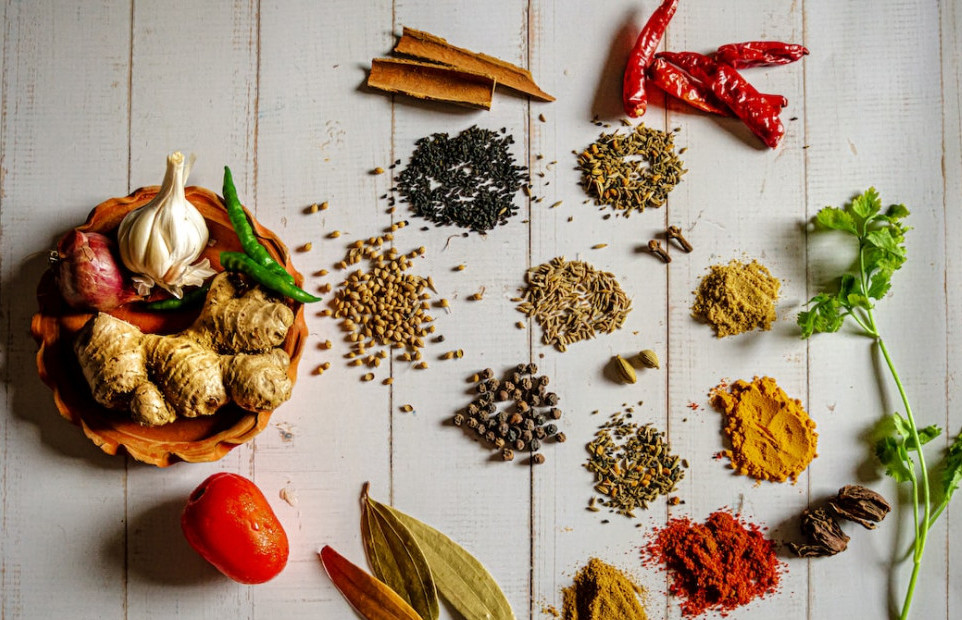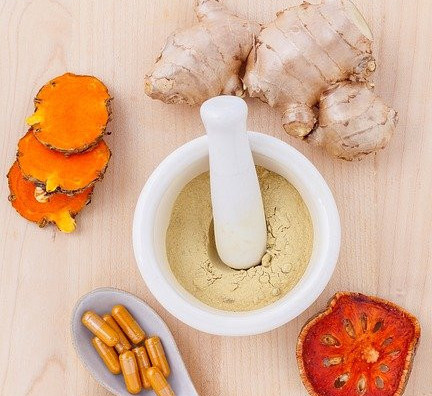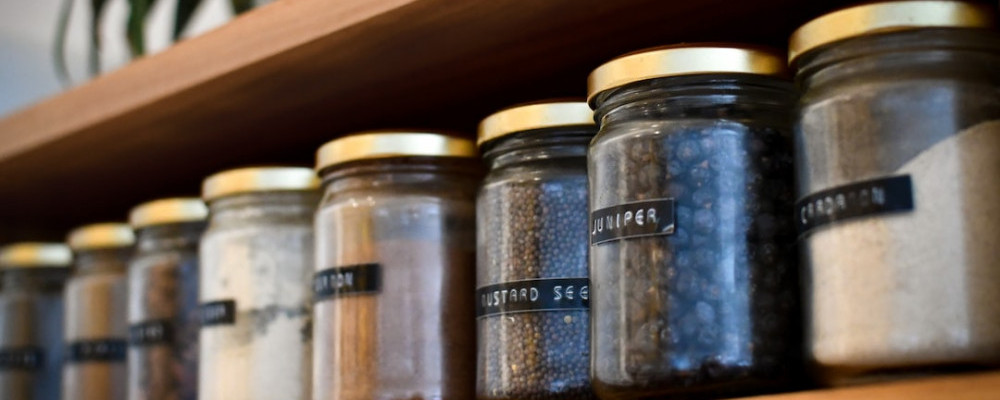 Do you use spices in your recipes when you are cooking? Spices make everything taste better.You must be careful and not use to much. Some spices can be overwhelming.
Do you use spices in your recipes when you are cooking? Spices make everything taste better.You must be careful and not use to much. Some spices can be overwhelming.
A pinch is a very small amount, not a quarter tsp. Follow the directions carefully when working with spices, to much of a spice can overwhelm your food you are preparing.
When you add a pinch of pepper or paprika to a recipe, it’s easy to forget that many common kitchen spices have uncommon origins.
So what is a Spice ?
A spice can be from a seed, fruit, bark or parts of different plants. Spices are all different shapes.
Which spice do you use the most in your cooking?
Salt
Pepper
Cumin
or none of the above? I personally salt and pepper everything I cook.It just makes everything taste better.

Spice Trade
developed throughout the Indian subcontinent and Middle East by 2000 BCE with cinnamon and black pepper, and in East Asia with herbs and pepper. The Egyptians used herbs for cuisine and mummification. Their demand for exotic spices and herbs helped stimulate world trade.
Individual Cooking Spice and where they originated from
Turmeric

Turmeric is a deep yellow spice from India that’s made by boiling, drying, and grinding the rhizome (underground stem) of a plant in the ginger family. It tastes slightly bitter and peppery and is often used in savory dishes. Some 4000 years ago, turmeric played a role in religious rituals, and it’s still used today in many Hindu weddings and spiritual ceremonies. Sometimes referred to as “Indian saffron,” turmeric is cultivated in India and Vietnam and grows wild in parts of Asia.
Paprika
Paprika gives a dash of bright color to deviled eggs and many other foods. It’s made from the dried pods of sweet bell peppers. Columbus introduced the plants to Spain after he returned from his voyage to the New World.
Ginger
This pungent spice comes from the rhizome of a tropical plant and dates back to about 500 B.C., when Confucius allegedly flavored his food with it, hoping to ensure a long life. Arab traders probably carried ginger from the Orient into Europe, but it almost disappeared after the Roman Empire fell. Marco Polo is credited for reviving its popularity when he found the plants growing in China and took them home to Venice. In Anglo-Saxon Britain, the rhizomes were boiled in sugar syrup as medicine. Queen Elizabeth may have invented the first gingerbread man when she ordered her bakers to make something edible in the likeness of her visitors. Today, many Asian dishes are spiced up with fresh or ground ginger.
Cumin
As you might guess from its leaves, cumin is in the parsley family. Cumin comes from an annual herb with fruits that resemble fennel seeds (in fact, cumin fruits are often referred to as “seeds.”) Some people dislike cumin’s strong aroma and flavor, but the early Greeks sprinkled it over foods the way we use pepper today. In ancient Egypt, cumin was one of the spices used for embalming mummies. This yellowish-brown spice came into the New World with Spanish and Portuguese colonists and merchants about 400 years ago. It’s frequently used in Mexican dishes.
Black Pepper
This spice originated some 4000 years ago from the green berries of a flowering vine native to India. The berries were cooked and dried until they shrank, leaving seeds with wrinkled, black skins—peppercorns. Pepper was once believed to have healing properties and was recommended by Hippocrates. Columbus was looking for riches, including pepper, when he set sail from Spain. As pepper became known around the world, its value increased until it was accepted as currency. Today, it accounts for one-fourth of the world’s spice trade.
Allspice
Allspice is not a blend of spices, but the dried, unripe berries of an evergreen tree native to the West India and the Central American tropics. While in Jamaica, Columbus mistook allspice for pepper and carried it back to Spain. Still an important ingredient in Jamaican jerk seasoning, curries and other foods, allspice has a warm aroma and tastes like a peppery blend of cinnamon, nutmeg and cloves. According to folklore, allspice aids digestion.
Oregano
Oregano is a Mediterranean herb that’s easy to grow in your garden. In Shakespeare’s day, it was believed to bestow good health and good luck. Throughout the ages, it’s been used as an antidote to poisons, a treatment for coughs and toothaches and as a snake repellent.
Saffron
Both Cleopatra and Alexander the Great are said to have used saffron in the bath—Alexander, to heal battle injuries, and Cleopatra, to prepare for her lovers. Made from the stigmas of crocus blossoms, saffron was introduced to Spain by Arab traders, where it became important in cooking. England’s Henry VIII was so fond of saffron, he executed anyone who sold it in a diluted form. Because of the labor required to obtain it, it’s now the world’s most expensive spice.
Anise
Native to the Middle East and eastern Mediterranean, anise, with its sweet, licorice flavor, is among the oldest spices. Pliny the Elder, a naturalist and philosopher, used it to treat insomnia; anise was also thought to ward off evil and help seers predict the future. During the Civil War, the seeds were made into an antiseptic for treating wounds until doctors realized this practice was toxic. Anise seeds are now used whole or in powdered form to flavor many foods, including black jellybeans.
Cardamom
Native to India, cardamom was mentioned in Egyptian writings around 1500 B.C. as a medicine and embalming spice. The pods of this plant, which belongs to the ginger family, were also chewed to sweeten the breath and “brush” the teeth. Alexander the Great’s soldiers may have introduced cardamom seeds to Europe around 325 B.C. Like saffron, cardamom, which has a warm, spicy flavor, is expensive because the pods are typically harvested by hand. The seeds can be baked into breads and pastries, while the pods can be added to sweet or savory dishes, including soups, stews, rice and curries.
Cloves
War broke out between the Dutch and the natives of the Molucca Islands as they competed for cloves in the spice trade. Cloves take their name from a French word that means nail, probably because these dried flower buds resemble nails.
Nutmeg
An evergreen tree from the Molucca Islands bears the fruits that produce both nutmeg and mace. After they mature, the pulpy fruits split open to expose seeds with red, netlike coverings. These coverings are dried and sold as mace, either in pieces or as a ground powder. After the seeds dry for a few more weeks, they’re cracked open to remove the inner nutmeats we call nutmeg. As they did with cloves, the Dutch tried to seize control of nutmeg trees on the island of Banda, killing many natives and enslaving others. Prices rose and stayed high until World War II, when the British and French started growing the evergreens in other parts of the world. Nutmeg is prized today for its warm, mildly sweet flavor.
Spice Storage
How to Store Spices So They Stay Fresh and Flavorful
Reduce Air Space
“If you buy spices in bulk, transfer them to a jar and move a portion to even smaller jars, if you can. The more air space in the container, the faster the spices will go bad,” Scommegna says. “If you have a few tablespoons of a spice left, for example, don’t leave it in a big pint jar.”
Choose Dark Jars
When doing a spice reconnaissance, opt for amber or darker-colored jars. This will protect spices from the harmful rays of the sun.
Identify Cool, Dry Storage Space
Where you store spices also figures into their longevity and flavor potential. Again, steer clear of hot spots and designate a dark, cool, dry space in your kitchen for your collection. “Spices will lose their flavor and potency if you keep them in sunny, hot corners of your kitchen, like next to the stove,”Some folks store extra spices in the freezer, but this exposes them to a lot of humidity, which is not ideal.
I purchase spices that are in glass. Purchase the good ones. Don’t buy the plastic containers of spices from the big box store. There are things in there that are not spices.
Take a walk thru the spice isle at the local supermarket. Try something new!
